
The Rokeby Venus is a painting by Diego Velázquez, the leading artist of the Spanish Golden Age. Completed between 1647 and 1651, and probably painted during the artist's visit to Italy, the work depicts the goddess Venus in a sensual pose, lying on a bed and looking into a mirror held by the Roman god of physical love, her son Cupid. The painting is in the National Gallery, London.

The Venus of Urbino is an oil painting by the Italian painter Titian, which seems to have been begun in 1532 or 1534, and was perhaps completed in 1534, but not sold until 1538. It depicts a nude young woman, traditionally identified with the goddess Venus, reclining on a couch or bed in the sumptuous surroundings of a Renaissance palace. It is now in the Galleria degli Uffizi in Florence.
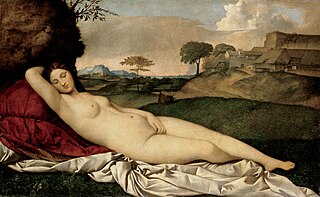
The Sleeping Venus, also known as the Dresden Venus, is a painting traditionally attributed to the Italian Renaissance painter Giorgione, although it has long been usually thought that Titian completed it after Giorgione's death in 1510. The landscape and sky are generally accepted to be mainly by Titian. In the 21st century, much scholarly opinion has shifted further, to see the nude figure of Venus as also painted by Titian, leaving Giorgione's contribution uncertain. It is in the Gemäldegalerie, Dresden. After World War II, the painting was briefly in possession of the Soviet Union.
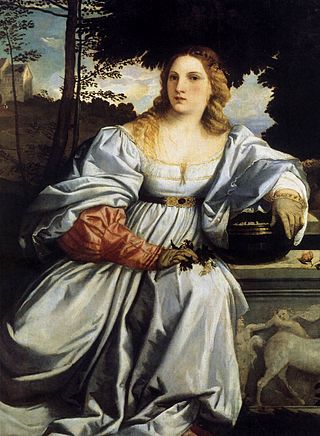
Sacred and Profane Love is an oil painting by Titian, probably painted in 1514, early in his career. The painting is presumed to have been commissioned by Niccolò Aurelio, a secretary to the Venetian Council of Ten, whose coat of arms appears on the sarcophagus or fountain, to celebrate his marriage to a young widow, Laura Bagarotto. It perhaps depicts a figure representing the bride dressed in white, sitting beside Cupid and accompanied by the goddess Venus.

Diana and Actaeon is a painting by the Italian Renaissance master Titian, finished in 1556–1559, and is considered amongst Titian's greatest works. It portrays the moment in which the hunter Actaeon bursts in where the goddess Diana and her nymphs are bathing. Diana is furious, and will turn Actaeon into a stag, who is then pursued and killed by his own hounds, a scene Titian later painted in his The Death of Actaeon.
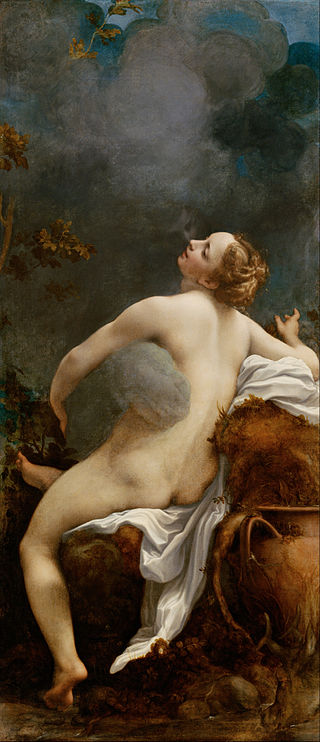
The Orleans Collection was a very important collection of over 500 paintings formed by Philippe d'Orléans, Duke of Orléans, mostly acquired between about 1700 and his death in 1723. Apart from the great royal-become-national collections of Europe it is arguably the greatest private collection of Western art, especially Italian, ever assembled, and probably the most famous, helped by the fact that most of the collection has been accessible to the public since it was formed, whether in Paris, or subsequently in London, Edinburgh and elsewhere.

The Venetian painter Titian and his workshop made at least six versions of the same composition showing Danaë, painted between about 1544 and the 1560s. The scene is based on the mythological princess Danaë, as – very briefly – recounted by the Roman poet Ovid, and at greater length by Boccaccio. She was isolated in a bronze tower following a prophecy that her firstborn would eventually kill her father. Although aware of the consequences, Danaë was seduced and became pregnant by Zeus, who, inflamed by lust, descended from Mount Olympus to seduce her in the form of a shower of gold.
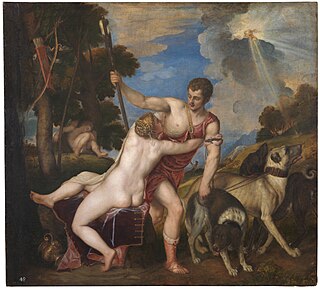
A composition of Venus and Adonis by the Venetian Renaissance artist Titian has been painted a number of times, by Titian himself, by his studio assistants and by others. In all there are some thirty versions that may date from the 16th century, the nudity of Venus undoubtedly accounting for this popularity. It is unclear which of the surviving versions, if any, is the original or prime version, and a matter of debate how much involvement Titian himself had with surviving versions. There is a precise date for only one version, that in the Prado in Madrid, which is documented in correspondence between Titian and Philip II of Spain in 1554. However, this appears to be a later repetition of a composition first painted a considerable time earlier, possibly as early as the 1520s.

Venus and Adonis is a painting by the Italian late Mannerist artist Paolo Veronese, executed in the early 1580s, now in the Museo del Prado, in Madrid.

The Flaying of Marsyas is a painting by the Italian late Renaissance artist Titian, probably painted between about 1570 and his death in 1576, when in his eighties. It is now in the Archbishop's Palace in Kroměříž, Czech Republic and belongs to the Archbishopric of Olomouc. It is one of Titian's last works, and may be unfinished, although there is a partial signature on the stone in the foreground.
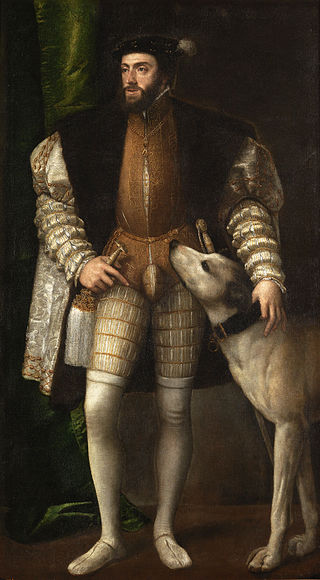
The Portrait of Karl V with a Dog is a portrait of Karl V, Holy Roman Emperor with a hunting dog, painted by Titian in 1533. It passed from Karl to the Spanish royal collection, from which it passed to its present owner, the Prado in Madrid.

Salome, or possibly Judith with the Head of Holofernes, is an oil painting which is an early work by the Venetian painter of the late Renaissance, Titian. It is usually thought to represent Salome with the head of John the Baptist. It is usually dated to around 1515 and is now in the Doria Pamphilj Gallery in Rome. Like other paintings of this subject, it has sometimes been considered to represent Judith with the head of Holofernes, the other biblical incident found in art showing a female and a severed male head. Historically, the main figure has also been called Herodias, the mother of Salome.

Venus with a Mirror is a painting by Titian, now in the National Gallery of Art in Washington, DC, and it is considered to be one of the collection's highlights.
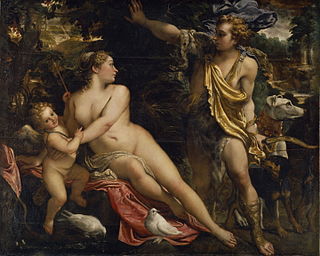
Venus, Adonis and Cupid is a painting created c. 1595 by Annibale Carracci. The painting is in the Museo del Prado, Madrid. Annibale Carracci was one of the most well known Italian Baroque painters of the seventeenth century. The Carracci brothers established an academy of art called Accademia degli Incamminati, which pioneered the development of Bolognese Painting. Annibale Carracci and Caravaggio were among the most influential artists of this century, who through their unique artistic styles led to the transition from Mannerist to Baroque. Annibale was born in Bologna in 1560 and died in Rome in 1609.

The Fall of Man is a painting of the Fall of Man or story of Adam and Eve by the Venetian artist Titian, dating to around 1550 and now in the Prado in Madrid. It is influenced by Raphael's fresco of the same subject in the Stanza della Signatura in the Vatican, which also had a seated Adam and standing Eve, as well as Albrecht Dürer's engraving Adam and Eve for smaller details. Owned at one point by Philip II of Spain's secretary, Antonio Pérez, and perhaps first commissioned by his father, in 1585 it entered the Spanish royal collection, where it was copied by Rubens between 1628 and 1629 for his own version of the subject.
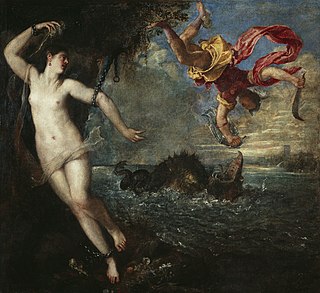
Perseus and Andromeda is a painting by the Italian Renaissance artist Titian, now in the Wallace Collection in London. It was painted in 1554–1556 as part of a series of mythological paintings called "poesie" ("poetry") intended for King Philip II of Spain. The paintings took subjects from the Roman poet Ovid's Metamorphoses, in this case Book IV, lines 663–752, and all featured female nudes.

The Pardo Venus is a painting by the Venetian artist Titian, completed in 1551 and now in the Louvre Museum. It is also known as Jupiter and Antiope, since it seems to show the story of Jupiter and Antiope from Book VI of the Metamorphoses. It is Titian's largest mythological painting, and was the first major mythological painting produced by the artist for Philip II of Spain. It was long kept in the Royal Palace of El Pardo near Madrid, hence its usual name; whether Venus is actually represented is uncertain. It later belonged to the English and French royal collections.

In 1635, Peter Paul Rubens created Venus and Adonis, now in the Metropolitan Museum of Art, New York. He followed the mythological story in the Metamorphoses by Ovid, inspired from his love of classical literature and earlier depictions of this scene. This oil on canvas painting shows Venus accompanied by Cupid, embracing and pulling Adonis before he goes off to hunt. The artist uses specific colors, detail and strong contrast between light and dark to depict a dramatic and emotional scene. At the time Rubens created the painting, the mythological story of Venus and Adonis was popular in Renaissance and Baroque court art. Rubens was clearly inspired by the many existing depictions of this scene, in particular the famous Titian composition of the same name, of which there are numerous versions. This depicts the same moment of Adonis leaving Venus to hunt, despite her pleas to stay. He is killed later in the day.

Salome, also known as Salome with the Head of John the Baptist, is an oil painting by the Venetian painter Titian, made in about 1550, and currently in the collection of the Museo del Prado in Madrid. It is not to be confused with other compositions of Salome and Judith by Titian.

A Blonde Woman, also called Flora, is an oil painting by Palma Vecchio, dated today to around 1520, but undocumented before 1870, in the collection of the National Gallery, London. This half-length depiction of a woman in loosened white chemise with a dark green mantle, holding some flowers, has been interpreted as an idealised representation of female beauty, and as an actual portrait of either a gentlewoman or a courtesan.


























